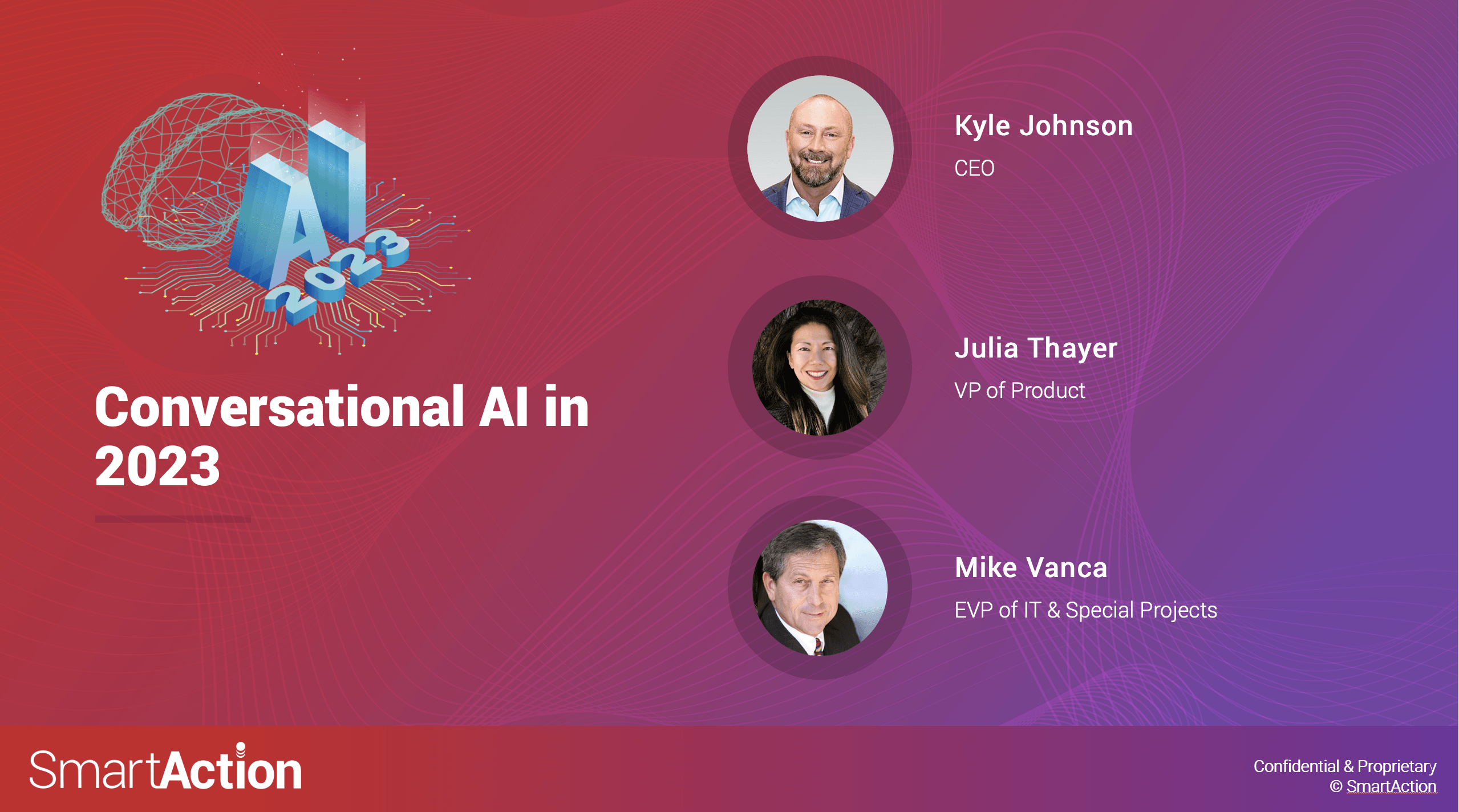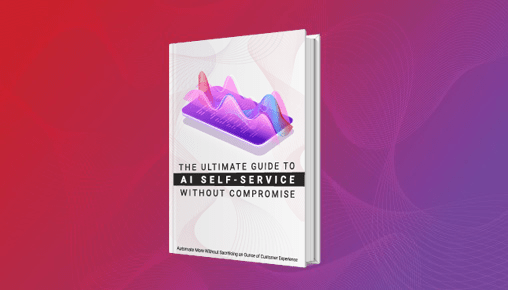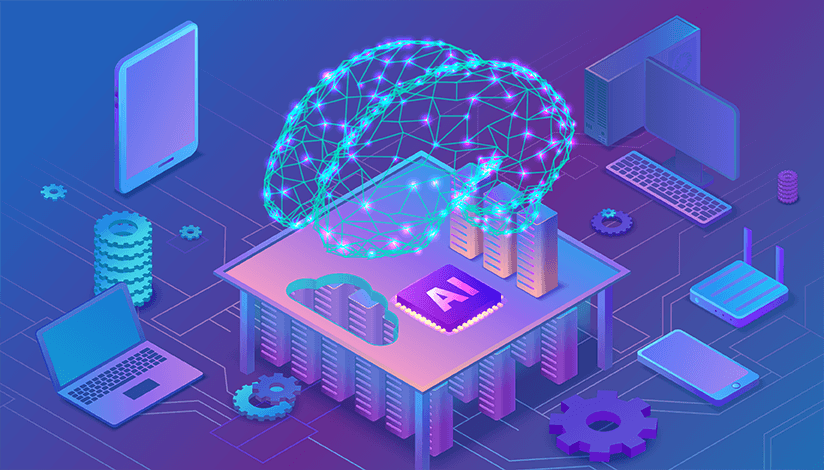Conversational AI in 2023

Watch the webinar to learn about the amazing things SmartAction has planned for the new year. Our new CEO, Kyle Johnson, will be sharing the virtual stage with other industry experts from our product and technology teams.
You’ll get industry-leading insight on how conversational AI is truly changing the game when it comes to customer interactions.
Watch This
Webinar

Kyle Johnson
CEO,
SmartAction

Julia Thayer
VP of Product,
SmartAction

Mike Vanca
EVP of IT and Special Projects, SmartAction
Conversational AI in 2023
On-Demand Webinar
EJ Fernandez (Host): Hello, folks. Appreciate you spending your lunch with us. We’ve got some exciting stuff to talk about. We’ll give it one more minute to 1:05 here and then we will begin. How’s it going, Toby? I see Greg, Bob, and Brandon. Hello Andy and Ashley. Looks like we’ve got Renny in the audience today. That’s good. Alright, what do you say, team? 1:05. Good to go.
Kyle Johnson (CEO): That sounds good.
EJ Fernandez (Host): Alright, good deal. Well, I want to make some introductions here. This is Kyle Johnson, our CEO. We’ve got Mike Vanca and Julia Thayer. I’ll give them a little bit bigger of an introduction here in just a second: kind of explain who they are and what they do for SmartAction. I want to go over our agenda and talk about what we’ll talk about today.
So conversational AI evolution — that’s Kyle. He’s going to talk about what he’s done since he’s come on as CEO here at SmartAction. Specific advances here at SmartAction with Julia. We’ll talk about staying ahead of the curve with Mike. He is a wealth of knowledge in this industry. And then we want to make sure that we have built some time in for questions that you may have.
So, feel free to pop your questions in now, as you’re thinking of them, in the Q&A section of the chat. So, we’ve got some really good stuff in store that you will find beneficial and, like I said, if you have questions or comments, pop them in the chat and we will go from there.
So, like I said, I want to introduce these guys and give them their proper introduction and how we can get to know them and what they’ve done. Kyle is our new CEO. He’s been CEO since November. So, Kyle, we’re really excited to have you. He’s been in the industry for over 25 years, leading software and technology organizations, focusing on delivering world-class customer experiences. He’s invested in on the board of multiple technology companies, many of which are in the communications and technology space.
Julia is our VP of Product and she oversees our product roadmap for improvement in our product delivery. She’s got a lot of experience and B2C and B2B, focusing on empowering customers and complementing human behavior with technology.
Mike has hands-on experience in technology and R&D, spanning about four decades. Something I think is so cool about Mike is that he’s worked on projects like F1 and Indy Car for driver training, doing AI-based driver training for teens and seniors. I think that’s so interesting. We’ll have to get lunch to talk more about that sometime. He is our EVP of IT and Special Projects here at SmartAction. So, he’s led the R&D, Engineering and Operation Teams during development, deployment and ongoing enhancements of SmartAction SAAS products.
I want to jump right into it with you, Kyle. I’ve got some questions for you and the first one would be, “What’s been the most exciting thing for you since starting as CEO here at SmartAction?”
Kyle Johnson (CEO): Yeah. Thanks, EJ. I appreciate that intro. First, we really want to give a big “Thank you” to all the attendees out there for investing time in their day to hang out with us for a few minutes and talk about what’s going on in conversational AI. So, we really appreciate you taking the time.
So far, the most exciting thing for me since joining back in November has honestly been the chance to get to know our customers better. I often tell people, and our folks in SmartAction have heard me say this, that building genuine relationships is one of the most important things you can do in both your personal and your professional life. So having the chance to get to know some of our customers, learn more about the pain points that they have, and learn about their strategic priorities has been really great. I always like to look for ways that our company can make people’s lives easier. So, understanding where our customers are at in their digital transformation journey and how we can be a big part of that is always really exciting for me.
EJ Fernandez (Host): Yeah, absolutely. That’s great. What would you say that you’re looking forward to in the future or future of SmartAction?
Kyle Johnson (CEO): Yeah, sure thing. That’s a really good question. And I think before I answer that, first, I’d kind of like to level set on where’s the market’s at? You know, the global conversational AI market, which really includes intelligent virtual assistants, or what we would call IVAs, is expected to grow at a CAGR, which is “compound annual growth rate” of in excess of 22% over the next few years. So really reaching over 14 billion by 2025, which is just a stone’s throw away from us at this point.
You know, conversational AI is also one of the AI domains that have filed the highest number of patents over the last three years. And then, according to Gartner, by 2022, which we just finished, 70% of white-collar workers will interact regularly with conversational platforms.
So, why is all of that important? Really, what I think it’s doing is highlighting that this market and the need for IVAs and what they can provide is only getting stronger. More and more companies are realizing that they have to evolve their support model to include multichannel communication and AI is a big part of that multichannel communication.
So, what do I look forward to in the future? You know, I think there’s a multitude of ways that we’re going to continue to see this market and this technology continue to evolve. You know, I think we’ll continue to see improvements in the NLU, which is “natural language understanding” models, that continue to deliver a more humanlike conversational experience. And by the way, they’re not bad now, but we’re going to continue to see those develop in such a way that’s quite remarkable. You know, there’s already products in the market for things like text-to-speech and human voice that will, I think, continue to blur the lines between what your customer interprets as a computer conversation and a human.
EJ Fernandez (Host): They might not even know.
Kyle Johnson (CEO): Yeah, that’s exactly right. You know, I’ve had a few calls where I had to ask myself, “Is this a real person or not?” So, it’s really cool to kind of see that technology continue to evolve. And, you know, the other thing I expect to see is companies will continue to leverage the existing technology while also finding ways to utilize their own IP to augment what I would call the “off-the-shelf” technology to drive a more meaningful and human-like experience. So, I think those are a couple of things.
The other really big thing I see, or I would expect to see, is on the data and analytics side. So, I don’t want to steal Julia’s thunder — I think she’s going to talk some more about that. But what I like to call “actionable intelligence” around the conversation side of your business holds a lot of potential. If I just think about SmartAction as a company, we have hundreds of thousands of voice and conversational transactions, or events, that run through our platform. So that is millions upon millions of data points and bits of information that could be aggregated and served back to the customer proactively to make more informed decisions about their business or their business operations. Right?
So, more quickly understanding why a customer is reaching out to you and what frequency to allow you to update a particular communication point or maybe proactively reach out to a customer, inform them about an event to provide a better-off customer service experience. Or, potentially, it informs you of a particular customer behavior around components of the product or service that you, as a business manager or owner, provide so that you can drive changes to increase that customer satisfaction with your brand and increase your revenue opportunity with your customer or prospect base.
So, I think those are a couple of the big things. And then from a goals perspective, I think what I’d like to see is our teams lead the way in continuing to improve that technology and overall customer experience: both the experience that we provide to our customer as well as the experience that they provide to their customers in that conversational AI and IVR market. I want our customers to really receive extraordinary value in the product and the service that we provide. And honestly, it’s been really exciting, over the past 3 1/2 months since I joined, to see just how excited and energized our team has become, you know, rallying around this mission of being the trusted voice of our clients, elevating our customer experiences and driving brand loyalty through personalized automated communications and conversations. So that’s a couple of the things I think that we should expect to see and some of the initial short-term goals I’ve got for SmartAction.
EJ Fernandez (Host): I love it. It sounds really exciting. Thanks, Kyle. By the way, I should have framed this at the very beginning — we want this just to be a conversation. So, if you, in the audience, feel like you want to chime in with a thought, let us know. And I can call some light to that and maybe we can discuss that here during our webinar.
So, Julia, now I’d love for you to give us an overview of what the IVA product looks like, maybe our product specifically and products that are out in the market, and talk about some things to look forward to that are in their future for us.
Julia Thayer (VP of Product): Absolutely. So, as a lot of our customers here, we’ve worked with you all to kind of build these very bespoke and really, like Kyle said, the trust, the voice for our client, because often we’re the first touchpoint for your callers. So, we’re in a position of honor to really be the extension of the brand to make sure that we’re offering that great customer experience. So, some of my favorite applications are ones where we’ve reimagined a little bit the multitenant application, because, for example, we work with our clients very closely to ensure that the customer experience is up to par with what you expect for your customers.
So, what we’ve done is found a way to make you even more scalable, because when I say “multitenant, “it doesn’t mean that here’s an out-of-the-box, very generic solution, because that’s not why you work with us and that’s not what we want to deliver to you. What we want to do is work with you, in conjunction, to create an application that you’re able to scale to multiple offices or divisions. And again, it gives a very consistent voice, a very consistent customer experience where you know what’s going on with your customers across the board and also helps us at SmartAction really understand how your business processes and how it works, and then allows us to really dive deeper into those metrics as well. So, we’re making sure that this continuous improvement is really driving the value for your business.
So, it’s been a very exciting time because it really allows us to help you with your voice needs as quickly as your business is growing, which, for us, it’s always a great partnership. So, we’re happy to be on that boat.
EJ Fernandez (Host): Absolutely. Is there a specific way that our applications, or just the advancements that we’ve been able to bring to our customers, are making a real difference that our customers can see right now?
Julia Thayer (VP of Product): I’m very biased when I say, “I absolutely think so.” And again, it’s really what Kyle has said, to set about “actionable intelligence.” We’re really diving into that to try to continue with continuous improvement and being able to listen to a lot of the calls that are going through in our hypercare after we go live. We do a lot of hypercare and we work with a lot of our clients to make sure that these calls are expected. We’re constantly monitoring how the calls are going, what are key pieces of improvement to make it smarter, and we’re constantly working with new technologies as well, exploring how we add additional value for the existing ecosystem within the client at SmartAction. So, that’s looking at even after the call is done, how we support our live agents with smarter ways to answer things or giving them better information.
And again, just being able to help our clients understand and refine based on better reporting and 2023 for us is all about analytics. We’re looking at providing more dashboards and more reporting, working in conjunction with our operations team to make sure that our clients are getting the customer point that they need. And, again, diving into those metrics. We’re just continuously refining it until you’re able to open your customer portal one day and look at it and go, “That’s what I need.”
EJ Fernandez (Host): Yeah, that’s awesome. Is there a specific metric or set of analytics that recently we’ve encountered where customers have said, “This is it for us” or “When we found this out, we needed to change this,” or, “When we found out this, we know we needed to make this look a little bit different”?
Julia Thayer (VP of Product): So, we’ve invested in a new dashboard where you see the breakdown of how everything flows down. So, that’s something we’re now introducing because you can easily see the flow of how customers go: 30% breakdown here, 20% breakdown there. And so, that, to me, is a great innovation because it’s an easy visualization to see where things are flowing, and when there’s a hiccup, how do we go back into call flow with our clients to make it to fix it? There’s not one single thing, because again, with all our different clients, they have different needs they’re trying to fulfill.
So, it’s hard to identify one. But these are one of the tools that we’re really using to dive into it, to make this a better product for everyone.
Kyle Johnson (CEO): Yeah. One of the things I would add to that real quick is as we talk about the trends and what to expect in 2023 and beyond, it’s really good to talk about what we see in the market, but we’ll be innovative and find ways to provide that value to our customers and the functionality of the platform. But the other big part that I love about how SmartAction approaches it is that we also like to listen to our customers. Having a customer-informed product roadmap is the other big key that I think helps us differentiate and really provide that extra value. We don’t want to go work on a bunch of things that we just think are cool. We like to talk to our customers and find out what things add value to you, and then we incorporate that in our roadmap and deliver and delight.
EJ Fernandez (Host): Yeah, it sounds like it for sure. That’s awesome. Very cool. So, Mike is our resident AI technology guru. I’d like to just ask you some questions about the technology, some stuff that is maybe popular that everybody’s talking about right now that I think you would have a really unique view on and would be able to speak with some authority here.
So right now, everyone is talking about chat GPT. That’s the new big thing and it’s an incredible product. How impressive is this new technology? It seems like magic to me. When it comes to conversational AI, would you say we’re ahead of that curve or are we way behind this technology? What does our relationship in conversational AI look like with chat GPT, this big new shiny product?
Mike Vanca (EVP of IT and Special Projects): Sure, chat GPT is pretty interesting. It’s pretty amazing what it does. But it uses a large language modeling, which is pretty new and takes a phenomenal amount of hardware and resources. So, it’s using some pretty advanced techniques. We’re on a little bit different level. We are more industry specific or vertical specific, although chat GPT is something we could definitely look at incorporating, especially on our new platform. We have a lot of hooks built in so that we can use the latest and greatest technologies that are coming out. So, are we behind the curve or ahead of the curve? We’re probably right in the middle of it because as I said, with our new things that we have coming out, we have the ability to incorporate new language models, existing functionality, chat GPT if necessary, as it’s being monetized into the new platform to utilize that and bring that to our customers as well.
So, pretty cool technology. It uses something called “human reinforcement learning.” So, a human-in-the-loop machine learning to keep it on par. And that’s what chat GPT uses and we’ve used some variant of that at SmartAction for quite some time as well.
Kyle Johnson (CEO): I’ll add to that, and I think that’s a great explanation, Mike. What GPT does is it also provides a more human experience in the conversation— that’s what they do really well today. And of course, as Mike mentioned, it has to use the LLM as kind of the component to go out and reach and find the information and do that. But what it doesn’t do today, and again, what traditional IVA does is actually be able to perform actions for a business, right? So, I’ll just give some examples. If I need to schedule an appointment, process a payment, or make an outbound call for collections. There’s hundreds of different things that it does. Chat GPT is really something that you can look at to potentially augment how the service or how the technology performs.
EJ Fernandez (Host): Yeah, Yeah, very cool. Mike, what would you say some common misconceptions about AI might be right now?
Mike Vanca (EVP of IT and Special Projects): Well, there are some interesting ones. People always think of AI more of at an AGI level. So, two distinct, different things: AGI is “artificial general intelligence,” which we’re quite a ways from. It’ll take a phenomenal amount of computing power to get that. But AI, which is what we use and what is out there in industry, does more task-specific things that people do. And it’s been around for a long time. People think it’s fairly new, but I mean, I started working with AI in the eighties. These were programming machines out on a factory floor to do what a human used to do, which is one of the definitions of AI. So that’s a common mistake.
There’s a common misconception is that it’s this all-encompassing thing. It may very well one day be, but right now it’s specific to certain tasks which we use for conversation. It can be used in a lot of different experiments and sciences to help augment what people do.
Another common misconception is that if you understand it, it’s no longer AI, but AI is in what people utilize every day. They just don’t understand or just don’t see that AI is around everyone and it’s just part of everyone’s life at this point.
EJ Fernandez (Host): Yeah. Very cool. So, let’s say we have an application launched, right? We’re in. We’ve got everything set up. How often does that application need to be tuned from just an ongoing continual operation standpoint or to help it keep learning? And how difficult is that to do?
Mike Vanca (EVP of IT and Special Projects): Moreso, we tune applications continuously for the life of the app. Obviously, at the beginning there’s a lot more intensive tuning. As we learn more how callers are reacting, we may change wording and we do apply best practices to an immediate rollout. But then the “Wild Wild West,” as I put it, is how callers are really interacting with the conversation — sometimes it’s not predictable. So that level of tuning, especially at the beginning, has to be pretty intensive: daily or weekly. More often we do statistical tuning where we look at where people drop out. As Julia said, in our dashboards coming up you’ll be able to actually, visually, see that. But currently, our internal teams do statistics based on where people drop out, what things are good, and if we see something good, can we implement that in other parts of the conversation as well.
So, the tuning is constant. Part of the tuning efforts that we do is listening to calls, because what ends up happening is that we hear people asking for things that were not initially asked for by the customer and us in this conversation, so we can add more functionality into an application just by listening calls and saying, “Well, here’s something we never thought people ask for.”
So, the tuning goes through the life of the app. It’s an optimization that the statistics should constantly be increasing. It’s an ongoing thing and it’s actually a lot of fun to do, to watch and see how people react and how we can help those people accommodate.
EJ Fernandez (Host): Very cool. That’s a lot of really good information. So, we’ve got some time left on the end. Why don’t we go to some questions. One question is about sentiment analysis. Natalie asks, “Do you use sentiment analysis, picking up on confusion or frustration with the customer journeys, maybe even happiness? Can we tell when somebody’s having a really good experience?”
Julia Thayer (VP of Product): I’m happy to pick this one up. So, sentiment analysis is one of those areas where we’ve been actively looking into. We actually did a quick proof of concept in the past few months. We’re trying to see the best way to incorporate it because, with this business, we’re always looking for a balance of having a good experience. So, like you said, Natalie, if you’re feeling frustrated with it, it’s about balancing: at what point do we want to switch them on to an agent, but then will we lose that containment? So, it’s this art of conversation we’re trying to refine, but that’s absolutely something that’s in our roadmap to come up soon.
EJ Fernandez (Host): Great. Another question is, “Is IBM Watson a GPT or AGI?”
Mike Vanca (EVP of IT and Special Projects): It’s definitely not AGI. I think currently they’re using GPT 3, which is the latest level of machine learning and training. So yeah, definitely not AGI. That is not in existence today as we as we talked about earlier.
EJ Fernandez (Host): Gotcha. We talk about the IVA. It kind of sounds like IVA might be an outright replacement for the IVR, kind of your traditional phone-tree style system. Is that true?
Kyle Johnson (CEO): I’ll take the first stab at that. So, can it be a replacement outright? Yes, it absolutely can and we do quite a few of those. But really, to get the value of what the intelligent virtual agent does, I wouldn’t look at the solution just to be the IVR. Right now, IVR is really just routing calls to an appropriate area, which in IVA, like what we provide does. But again, it’s kind of taking that next step of not just getting it to the right location, but from a containment standpoint, processing a complex request or need that the customer has. So, the simple answer is yes, it can be, but would you really get full value out of that? Probably not. You really want to look to replace some of those tasks that can be done by the system.
EJ Fernandez (Host): Okay, cool. Julia, this one is a little bit about customer satisfaction. So, they ask, “Can you speak on customer satisfaction between virtual agents and live agents? What does that comparison look like with your clients?”
Julia Thayer (VP of Product): I think it really depends on the task at hand. Because and I think, unfortunately, this is one of those “It depends” answers, because it also depends on whether the customer is looking at “How do I get through this process quickly?” For example, if I’m stuck on the side of the road and I don’t want to wait an hour on hold for a live agent to be able to get help there, I would prefer having this quick, easy way of doing it where they pick up my phone number and they have all my information on file, whereas there’s going to be more complex ways of doing things which people may prefer a live agent. So, I think in different scenarios you’ll see different ones.
And so part of what we do as SmartAction is try to help you define what those use cases are, where people are happy to say, “Let’s talk to the virtual agent because this is the fast, most effective way to get from point A to point B, and if there’s a more complex situation that has to be managed, at what point do we then maybe transfer to a live agent to get all the support that I need?”
EJ Fernandez (Host): Yeah, that makes sense for sure. Yeah.
Kyle Johnson (CEO): The other thing is that because we have so many different customers and handle so many transactions, we also get to share best practices. In addition to that, with the conversational flow, we can share best practice there, which again, should continue to drive your customer satisfaction scores up as well.
EJ Fernandez (Host): Yeah, that makes a lot of sense. The last question that I see is, “What are typical challenges you see during the transition into adopting a conversational AI platform system?”
Mike Vanca (EVP of IT and Special Projects): Part of it actually goes back to the NPR scores and the customer satisfaction pieces. But I’ll touch on that at the end.
Some of the more, I won’t say just “challenges,” but some of the more “interesting things” that we get to do is take the customers’ live agent conversations and try to analyze those and ask, “How can we make that more amenable to an AI-based, consistent set of questions?”
So, while live agents can talk a lot and get more information around things easily, for us, we have to be able to design a conversation in a way that we get the answers that we need with the least amount of difficulties to the caller. That’s one of the biggest challenges.
And then building out what callers are going to ask for when we do get that. So those are kind of the cool things we get to do because it ends up being pretty interesting listening to all these things and the challenges of making that happen and watching those, as you said, NPR scores.
So, to go back to the one thing about live agents and learning, we had some really interesting results when we first started our roadside assistance pieces, where we had a customer who called me up and asked, “How can our NPR scores go up? We’re using an automated system.” And it ended up being that people wanted to get to an agent — they wanted to get their problem logged and get going, and then they got a return call. On the back side of that, we had another customer, that same type of a scenario that had their NPR scores drop, and after analyzing it, it ended up not being us — it was after we transferred to a live agent. It was the way it was handled after that. So, with a little bit of training for the live agents, that brought that back up.
So, to go back to “what are some of the challenges in implementing,” it’s not just the piece that we do on our side. It’s also, once we implement an intelligent virtual assistant, it is training or letting the live agents know how they can best enhance the experience that we have started once we transfer it to them.
EJ Fernandez (Host): So, it sounds like it’s a partnership. So, we’re kind do our end and then work with the client to make it work really well.
Mike Vanca (EVP of IT and Special Projects): It is absolutely a partnership: that level of relationships that I talked to before. That’s what I enjoy the most with working with our customers, because some of the relationships we have had for over a decade. We have customers with us for over 12 years now, and that relationship and partnership to enhance their business and learn about it and help them expand is key and it’s what makes a lot of this really worthwhile.
EJ Fernandez (Host): Another audience member is asking, “How easy is it to integrate your IVA with a contact center legacy system?”
Mike Vanca (EVP of IT and Special Projects): I’ll take that one again. So, it’s not very difficult if there are APIs – we’ll utilize those APIs. Telephony is the another piece to look at when we transfer to a live agent, we would love to be able to send over any of the answers to the questions that we’ve asked in our automated system to that live agent desktop. So, they certainly don’t want to ask that again, but they also have more information. So, it’s not difficult.
We’ve even done SFTP. If you don’t have an API and the conversation lends itself to not needing real-time data, outbound calls are a good example. So, it’s a pretty straightforward process and we’ve done so many of them. We probably already have done an integration with the various pieces of equipment, telephony systems and systems out there.
Kyle Johnson (CEO): You know, I chuckle just a little bit when I hear you say, “It’s not difficult,” Mike, because you’re incredibly technical. I’m a fairly simple guy. I know I wouldn’t try it myself. I think the caveat to what Mike just said is that it’s not difficult as long as you have a partner that is experienced in doing so. And so, given that you’ve got a company with an incredible amount of expertise there, it should be seamless for you, as a customer, but it actually is pretty hard to do. So that’s the one caveat I would make.
EJ Fernandez (Host): Makes a lot of sense. Mike, we’ve got a question kind of piggybacking off the previous answer that you gave us about modeling or increasing efficiency and effectiveness of an actual human agent. One of our viewers asks, “Do you ingest the audio files of the more tenured contact center reps? How do you decide who to go off of to tune your application?”
Mike Vanca (EVP of IT and Special Projects): That’s a really good question. We want them all because it’s really not as much about the tenured live agents. It’s, “What are the callers asking for so that we can react to that?” The questions and the way that a tenured live agent asks them is what we use in the design of the conversation, but in the way we actually handle and listen for things, we use them all.
The tenured line of agents in the past, we have gone to the call centers and customers and sat down with those agents for a day and actually listened in to their conversations. We get a really good idea of how they handle the different scenarios that callers could ask for.
EJ Fernandez (Host): Maybe that’s another example of that partnership that you’re talking about. It’s a process working with a customer to get the application right.
Mike Vanca (EVP of IT and Special Projects): So going to a call center and sitting down with a live agent and then the manager comes up and says, “Well, this gentleman is going to sit with you for the day and listen to you.” And there’s kind of apprehension. I said, “No, no, no, we’re not going to listen to you for anything other than we want to learn from all the good things you do,” and then they kind of loosen up and we have a good time.
EJ Fernandez (Host): Yeah, that’s got to be the employee of the month at that call center. It looks like we’ve got one more question, “I’ve heard that language models can learn over time. Can I hear more about that and how are language model platforms developed?”
Mike Vanca (EVP of IT and Special Projects): When you deploy a language model, initially, you use several pieces, but it’s a lexicon, the amount of words you use, and then the sounds that come with that. So, there’s an initial deployment of a base model, and then, over time, you can augment that by adding grammars to it or retraining the model if there’s a new algorithm that we use or new mathematical algorithm to look at the different ways people say words, we’ll implement that. But that’s based on need and technological advancements. I mean, obviously we went from GPT 2 to GPT 3. We use reinforcement learning at SmartAction, with a human-in-the-loop piece. So that’s also how we improve our recognition of NLP and NLU.
So, it’s done through various ways. Obviously, there’s automated machine learning, but then there’s also human-in-the-loop augmentation. And then there are also, I would say, vertical- or question-specific things that we do at SmartAction to enhance recognition and caller experience.
EJ Fernandez (Host): Any other comments on any of that from our panelists here before we close up?
Kyle Johnson (CEO): No, I’m not even going to touch some of the technical stuff Mike just went through. That’s his area. I’m going to leave that alone.
EJ Fernandez (Host): Sounds good. Alright, that just about wraps it up for us. We’ve got a little QR code here on the screen — scan it to get more information about the things that we talked to you today. It’ll just prompt an email draft to send from you and what that’ll do is just put you on the fast track to talking with one of our experts here at SmartAction.
So, if you have questions about the SmartAction products or about AI in general, we would love to help you. We’ve got some pretty smart folks here onboard and folks that would love to help you and your business take the next step.
We really appreciate you tuning in and we can’t wait to hear from you in the future. I hope you guys have a great rest of your Wednesday.
Watch the webinar to learn about the amazing things SmartAction has planned for the new year. Our new CEO, Kyle Johnson, will be sharing the virtual stage with other industry experts from our product and technology teams.
You’ll get industry-leading insight on how conversational AI is TRULY changing the game when it comes to customer interactions.





